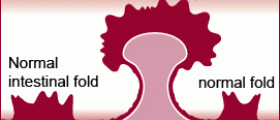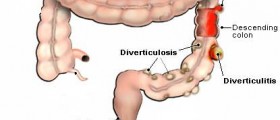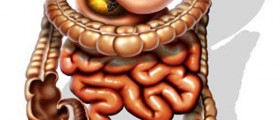Benign bowel tumors are rare clinical entities and they generally remain asymptomatic throughout life. They either develop as single lesions or multiple tumors of several subtypes. Benign bowel tumors include hyperplastic polyps, adenomas, GI stromal tumors, lipomas, hemangiomas and tumors associated with Peutz-Jeghers syndrome.
Such tumors are slow-growing and may affect different parts of the gastrointestinal tract including the duodenum, jejunum, ileum and colon. They grow inside the intestine (intraluminal tumors) or develop as infiltrative and serosal benign tumors. Intraluminal tumors are responsible for secondary bowel obstruction and intussusception and the serosal lesion may lead to volvulus.

Clinical Characteristics of Benign Bowel Tumors
As it has already been mentioned benign bowel tumors are most commonly asymptomatic. In case there are symptoms and signs of the disease they include loss of appetite, early satiety, nausea, vomiting, diarrhea, constipation, melena and GI hemorrhage./
Some of the potential complications associated with benign bowel tumors are volvulus, obstruction, anemia, intussusception and a bowel perforation. Large tumors may be palpated as huge masses in the abdomen.
Types of Benign Bowel Tumors
Hyperplastic polyps are benign mucosal growths that generally affect the duodenum and proximal ileum. These tumors are either single or multiple and are usually asymptomatic. Hyperplastic polyps never transform into malignant tumors and can be successfully removed endoscopically with biopsy forceps or an Endosnare.
There are several subtypes of adenoma, one more group of benign tumors of the intestine. They include adenomatous polyps, Brunner gland adenomas and villous adenomas. These tumors may cause obstruction, bleeding, intussusception and in some cases malignant degeneration.
Gut stromal tumors are the most common small bowel tumors that produce symptoms. They develop in a form of intraluminal masses, extraluminal masses or transmural lesions. In some cases, the tumor may develop surface ulceration and/or deep necrosis and in such patients bleeding and marked hemorrhage develops as the most common complications. Apart from bleeding these tumors are responsible for the obstruction, intussusception, tumor perforation and potential malignant degeneration.
Lipomas are benign submucosal tumors that predominantly develop in the ileum. Only if they grow large enough they cause colicky abdominal pain and intermittent bowel obstruction or intussusception.
Hemangiomas are vascular tumors and they rarely affect the intestine. There are several subtypes of hemangiomas and they include capillary, cavernous and mixed hemangiomas. These tumors in the majority of cases cause intestinal bleeding and are also connected with obstruction, intussusception, formation of intramural hematoma and perforation.
Tumors associated with Peutz-Jeghers syndrome are benign gastrointestinal hamartomas. These tumors are located in the small intestine in almost 90% of all patients. Even the stomach and colon are frequently affected and the tumor may develop outside the gastrointestinal tract. Such tumors develop as a consequence of mutation in the LKB1 gene (19p2,3). Secondary complications develop in case there are multiple hamartomas in the gastrointestinal tract. They include colicky abdominal pain, gastrointestinal bleeding and obstruction and in some cases the tumor may undergo malignant alteration.
- In a study, diagnostic sensitivity of detecting adenomas was 69%, while specificity (the accurate diagnosis of hyperplastic polyps) was 86%. One of the multiple hyperplastic polyps should be excised to confirm the true nature of the lesion.
- A hamartoma is composed of an abnormal mixture of normal tissue. They may occur sporadically or be associated with the rare autosomal dominant juvenile polyposis syndrome.
- Juvenile polyp (congenital polyp, retention polyp, juvenile adenoma) usually occurs in children under ten years of age. The incidence in boys (men) is higher than in girls (women). It is the most frequent colorectal tumor in children. Nearly 80% occur in the rectum but they may be scattered throughout the colon. The majority of these polyps are larger than 1 cm in diameter. The section surface shows a cystic appearance with spaces filled with mucous.
- Peutz-Jeghers’ polyps occur singly or multiple in the Peutz-Jeghers’ syndrome which is a rare autosomal dominant disease. Multiple polyps are scattered throughout – the entire gastrointestinal tract and melanotic mucosal and cutaneous pigmentation around the lips, oral mucosa, face, genitalia and palmar surfaces of the hands. They tend to be large and pedunculated, histologically, it’s a network of connective tissue and well developed smooth muscle extending into the polyp. In 100% these polyps occur in the small bowel (colon 30%, stomach 25%).
- Inflammatory (pseudo-) polyps representing nubbins of inflamed regenerating mucosa surrounded by ulceration, are seen in patients with long standing inflammatory bowel disease (ulcerative colitis or Crohn’s disease).
- A lymphoid polyp (lymphoid hyperplasia, benign lymphoma) is a benign, focal or diffuse condition that occur typically where clusters of lymphoid follicles are present (terminal ileum, rectum). A lymphoid polyp is characterized radiographically by small, uniform localized or generalized polypoid lesions. Endoscopic examination with biopsy confirms the nature of the polyp.
- www.nhs.uk/conditions/bowel-cancer/
- www.nhs.uk/conditions/bowel-polyps/
- Photo courtesy of National Cancer Institute via Unsplash: unsplash.com/photos/z8ofh6Zkn4k

















Your thoughts on this
Loading...